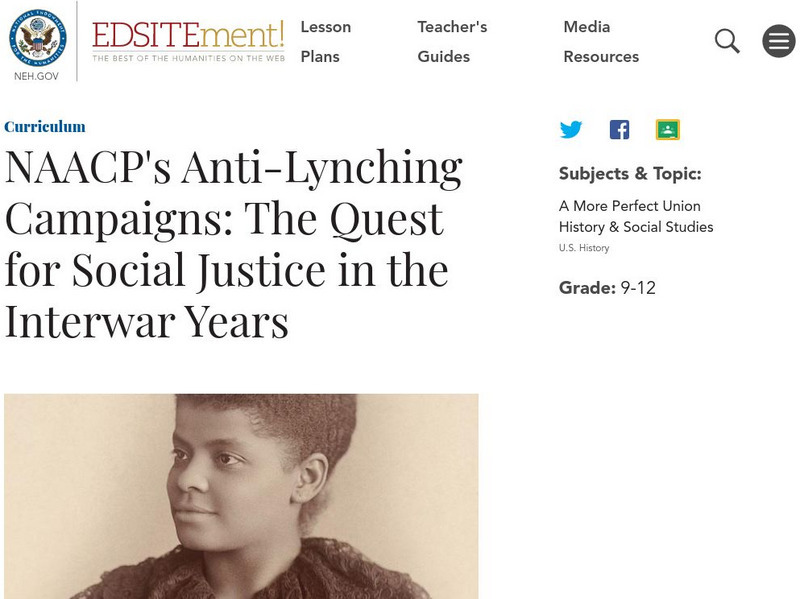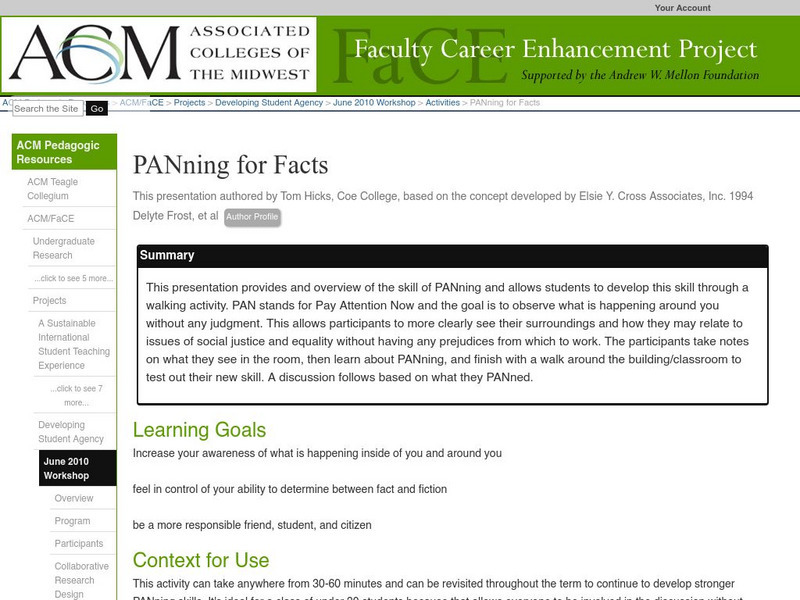Curated OER
Keeping our Water Clean
Second graders discuss how our actions impact the quality of water. In this environmental science lesson, 2nd graders watch a short film and discuss the problem of polluted water. Students are then divided into groups and record their...
National Endowment for the Humanities
NAACP’s Anti-Lynching Campaign in the 1920s
Students investigate the anti-lynching campaign of the NAACP in the 1920's. In this human rights instructional activity, students prepare for and participate in a simulated debate of the Dyer Anti-Lynching Bill that was presented to...
Media Smarts
Bias in News Sources
As young consumers of media, it is important for high schoolers to explore concepts of bias and prejudice, and how they may be present in media. After discussing ideological messages that media can contain, individuals complete a warm-up...
Robert F. Kennedy Center for Justice and Human Rights
Van Jones: Police Brutality
Develop an understanding of how the media and society are connected and responsible for the defense of universal human rights. Learners investigate and examine the conflicts of police brutality as it is portrayed in the media and through...
Curated OER
Investigating the Harlem Renaissance
The work of Langston Hughes opens the door to research into the origin and legacy of the Harlem Renaissance and how the literature of the period can be viewed as a commentary on race relations in America. In addition, groups are assigned...
Curated OER
Human Rights
Students read the Universal Declaration of Human Rights and then research countries which have had human right violations.
Curated OER
Compare and Contrast Night to Life is Beautiful
After reading Elie Wiesel's Night, watching the movie Life is Beautiful, and researching World War II, class members write a comparison essay on the book and film. This includes a prior knowledge activity, discussion in whole and small...
Curated OER
Cry, The Beloved Country: Anticipation Guide
“Poor people are poor because they are lazy and don’t work enough.” “If you are desperate, the means justify the ends.” Prior to reading Cry, The Beloved Country, class members complete an anticipation guide that focuses on issues raised...
Curated OER
Barnyard Protest: Cows, Chickens & Fundamental Freedoms
Here is an ambitious and engaging lesson that should help elementary schoolers begin to develop a basic understanding of human rights. Pupils are asked to think about their own rights, the rights of others, and how an individual's voice...
EngageNY
Understanding Box Plots
Scholars apply the concepts of box plots and dot plots to summarize and describe data distributions. They use the data displays to compare sets of data and determine numerical summaries.
Curated OER
Words That Hold Court
Students recognize the importance of the Supreme Court. In this legal terminology lesson plan, students define a list of words to understand the Supreme Court and the language used in cases. Students revise a case summary.
Curated OER
Fair Judgment
Students consider the demands of the judicial process and work in small groups to write editorials in response to the one that is read in class. For homework, they grade a television judge and write reflective essays.
Curated OER
To Protect And Serve? Debating Police Misconduct And Reform
Students discuss purpose of law enforcement, its relationship to the community it serves, and ways to combat police misconduct.
Curated OER
Westward Expansion
Middle schoolers explore the Westward Expansion Movement of U.S. history. For this Westward movement lesson, students use primary and secondary source documents research personal accounts of those who travelled west during the era....
Curated OER
Language Arts: Twinning At-Risk Students
Students at-risk in high school and primary grades pair up to read and write together. They create books modeled after authors and illustrators. They hold a parents' day to display their completed books.
Curated OER
Wages, Earning Power, Profit, and Responsibility: International Lessons
Students participate in an interactive activity to determine where their clothers were made. They examine the lives of children from Latin America who harvest crops in the fields or manufacture apparel in factories.
Curated OER
Using the newspaper to learn about state and local government
Students investigate the purposes of state and local government. They categorize newspaper articles into state and local issues. Pupils summarize nonfiction text. Students given an oral presentation on a news report to the class.
Curated OER
Design and Construction of an Eco-House
Students are able to design, construct, evaluate and recommend materials for planned Eco-house to be built on campus. They investigate about good design and plan for construction. Students have a greater knowledge and appreciation of...
Curated OER
Courage to Be You: King Day
Students define discrimination and what its like to be a stranger.For this discrimination lesson, students research the lives of Vivien Thomas and Hamilton Naki. Students produce a wall display showing how they've overcome discrimination.
Curated OER
Water: The Incredible Resource
Students understand the importance of water in any ecosystem. In this water lesson, students recognize where water is found, the type of water found, and how water is changed in the water cycle. Students complete worksheets using...
National Endowment for the Humanities
Neh: Edsit Ement: The Quest for Social Justice in the Interwar Years
In this Curriculum Unit, students will consider "NAACP's Anti-Lynching Campaigns: The Quest for Social Justice in the Interwar Years" in 2 Lessons. The unit also includes worksheets and other student materials that can be found under the...
Science Education Resource Center at Carleton College
Serc: Pa Nning for Facts
A lesson plan to introduce students to PAN technique (Pay Attention Now) when looking at social justice or equality issues. Lesson hopes to discourage snap judgements. Includes worksheet and PowerPoint.
United Nations
United Nations Cyberschoolbus: Peace Education
There are five teaching units on peace education on this site, ranging for ages 8 to 14+. Topics cover ecological awareness, tolerance, social justice, global citizenship, etc. There are many links in the resource area for United Nations...
PBS
Pbs Learning Media: Martin Luther King Jr.: Civil Rights Leader
Students will explore how King's deep-seated commitment to nonviolence contributed to the expansion of social justice in the United States, particularly for African Americans.
Other popular searches
- And Social Justice
- Math and Social Justice
- Art and Social Justice
- Latino Social Justice
- Social Justice Lesson Plan
- Peace and Social Justice
- Music and Social Justice
- Rap and Social Justice
- Steps for Social Justice
- Economic and Social Justice
- Science and Social Justice
- Equality and Social Justice






















